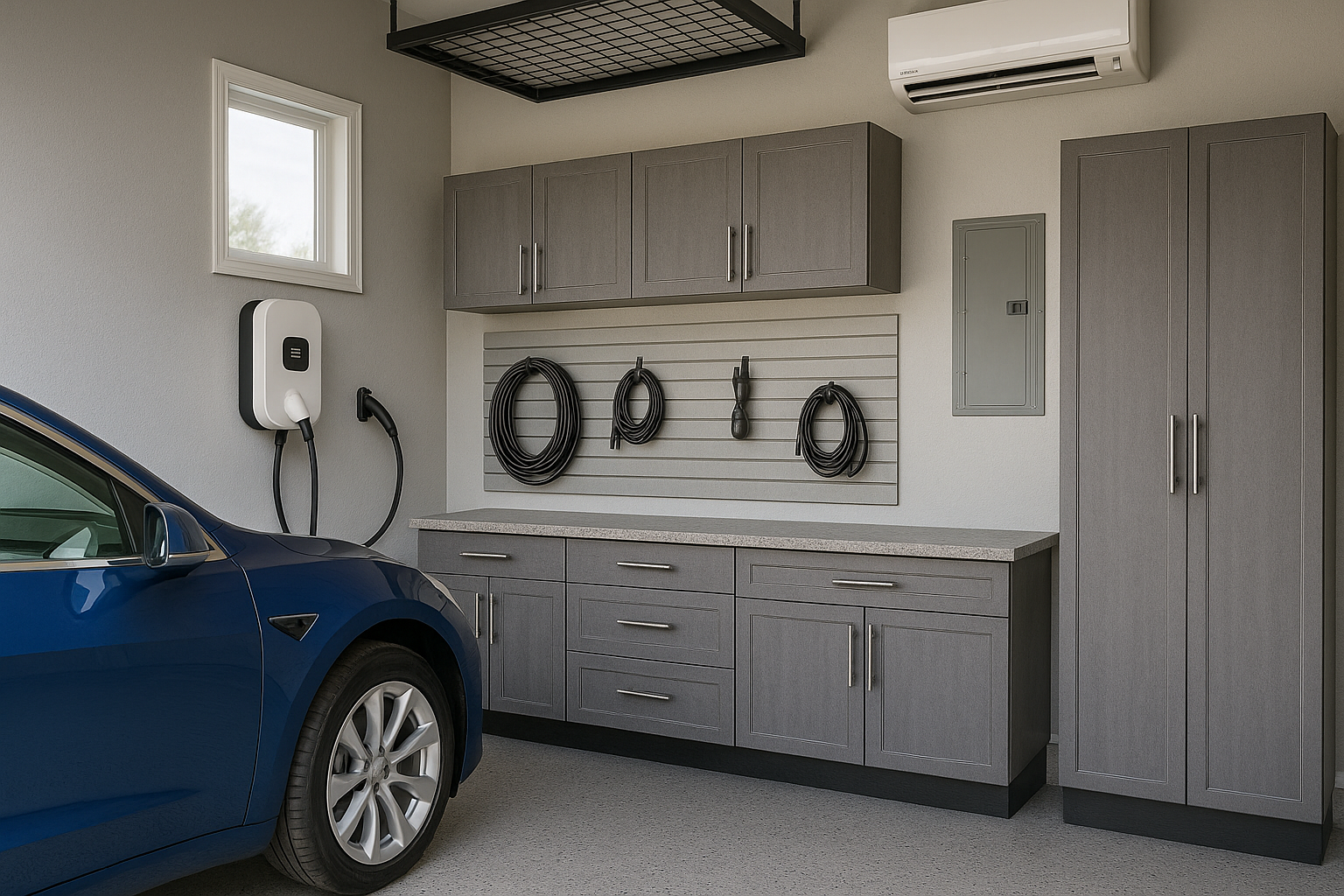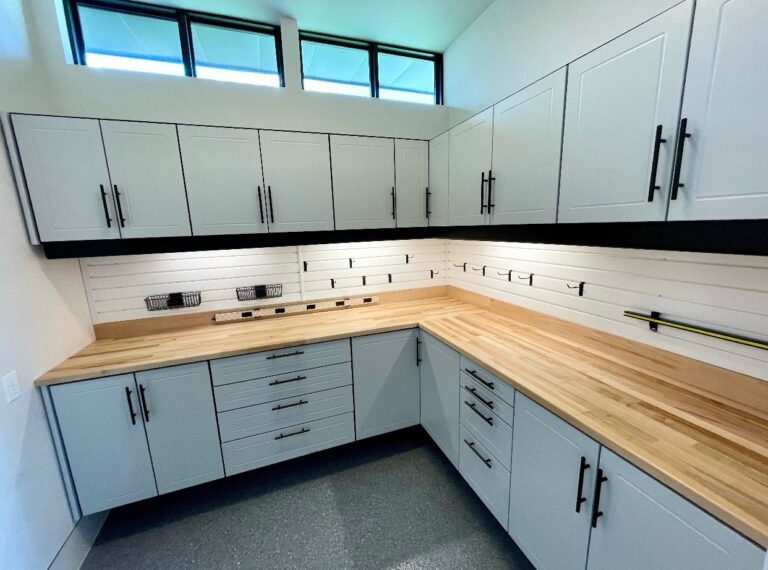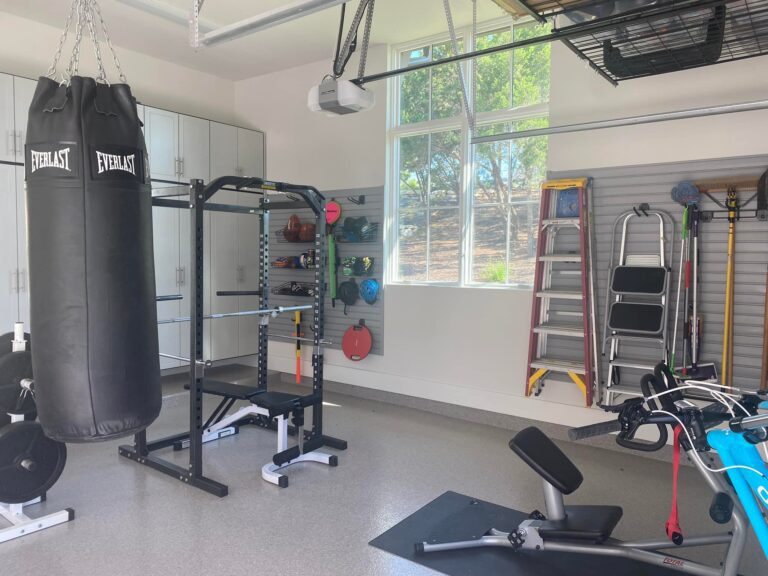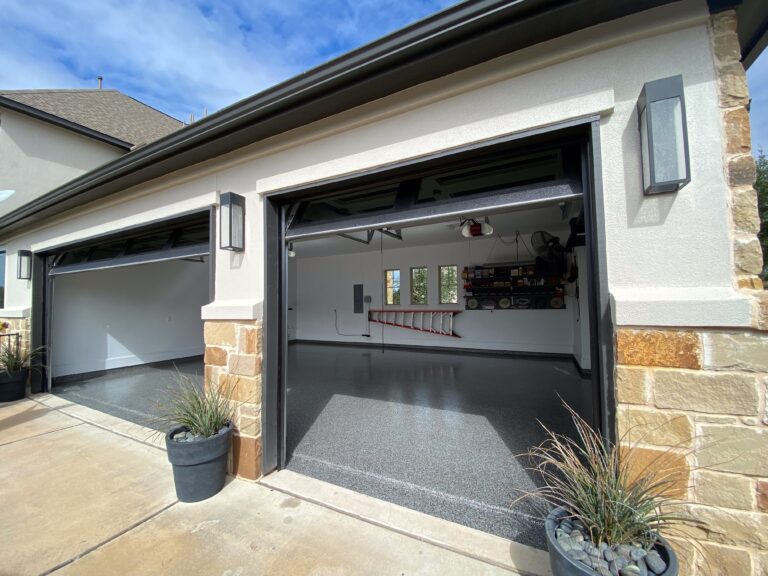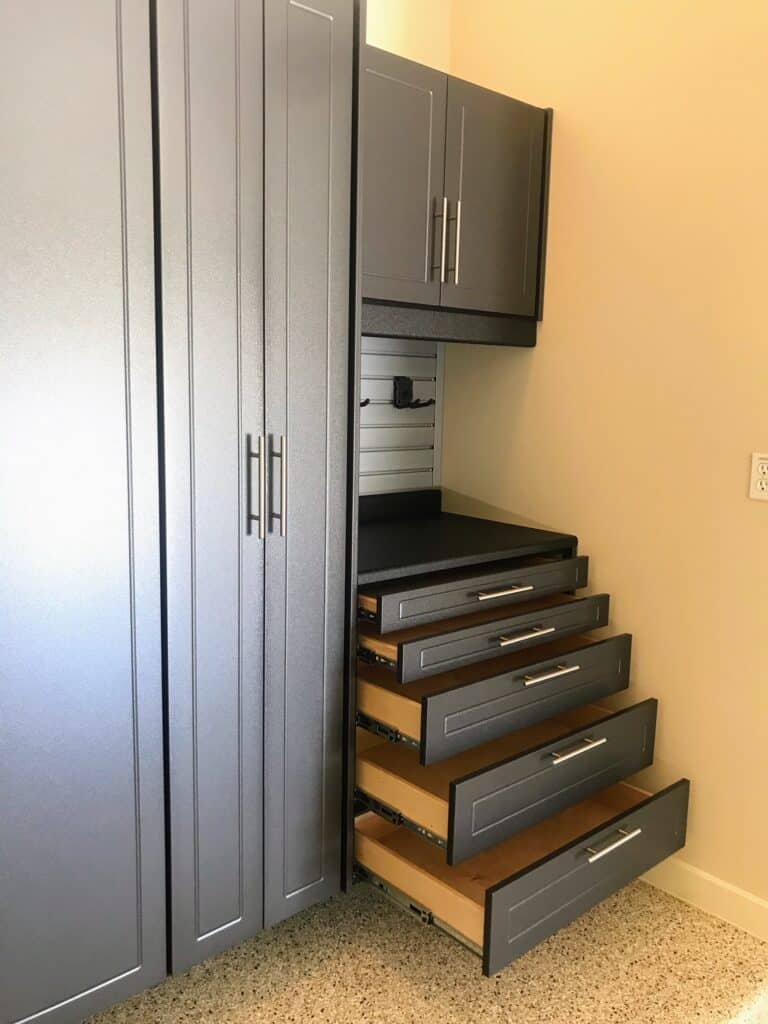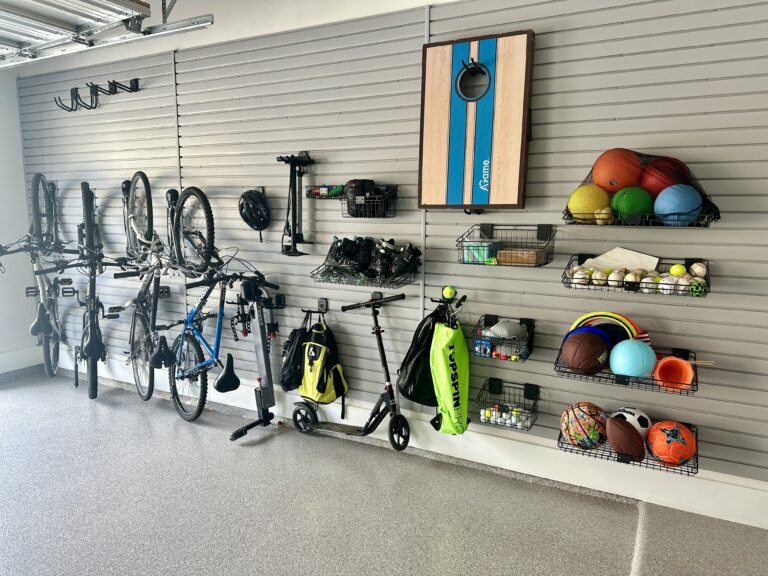Introduction: Your Next Vehicle Changes Your Garage
Electric vehicles are no longer a novelty—they’re fast becoming the default. But most garages weren’t designed with 40–80 amp circuits, cable management, battery safety clearances, or heat-resistant floor coatings in mind. If you’re planning to buy (or already own) an EV, your garage is about to do more than hold a car and a few bins. It has to charge safely, organize smartly, and stay durable under heavier, hotter EV tires and frequent in-and-out traffic.
At Black Diamond Garages, we design and build garages that work for how you live now—and how you’ll live five or ten years from now. Below is a complete guide to creating an EV‑ready garage: electrical planning, cabinetry and cord management, epoxy flooring that won’t peel under hot tires, fire and ventilation considerations, and future‑proofing tips most homeowners miss. When you’re ready, we’ll turn this checklist into a clean, high-performance space you’ll love walking into every day.
1) Start With Power: Electrical Planning for EV Charging
Level 1 vs. Level 2 (and why Level 2 wins for most homeowners)
-
Level 1 (120V, ~12A): Slow trickle charging via a standard outlet. Good for plug-in hybrids or extremely low daily mileage.
-
Level 2 (240V, 30–80A): The practical standard for most EV owners. Delivers 20–50+ miles of range per hour, depending on amperage, charger, and vehicle acceptance rate.
Panel capacity & load calculations
Before you mount a charger, make sure your main panel can handle it. Many Texas homes have 150A or 200A service—often enough, but not always after you add a 50A EV circuit, an induction cooktop, or a future spa. A licensed electrician (we coordinate this for you) can:
-
Run a load calculation to ensure code compliance and safety
-
Recommend a subpanel in the garage to future‑proof for a second charger, workshop tools, or a mini-split
-
Verify breaker size and wire gauge for your planned charger
Dedicated circuit & receptacle choice
-
Hardwired vs. plug‑in: Hardwired Level 2 chargers often support higher amperage and are cleaner visually. Plug‑in (NEMA 14‑50) is flexible if you plan to move the charger or switch brands.
-
Cable length & routing: Plan where the car will park, how you’ll approach the charger, and where to store excess cable. A 24’ cable can be great—until it becomes a tripping hazard without proper management.
Future-proofing for multiple EVs
Even if you only have one EV today, we suggest:
-
Running conduit for a second 240V line
-
Installing a panel with spare capacity
-
Choosing a smart charger that load‑shares when two vehicles charge at once
2) Charger Placement: Design for Daily Convenience
Where you put your charger dictates how tidy—or tangled—your garage feels.
Consider:
-
Driver’s side vs. passenger side charge ports (Tesla vs. many other brands)
-
Front vs. rear ports (common on some European and Asian models)
-
Pull-in vs. back-in parking habits
-
Walkways & doorways you don’t want to block with a charging cable
Our design tip: We often flank the charger with powder-coated RedLine Garagegear cabinets or a slatwall panel to contain everything you need—adapters, extension cords (for non-EV use), cleaning supplies, and wheel chocks—without visual clutter.
3) Cable, Adapter & Accessory Management (The Most Overlooked Part)
An EV cable on the floor is a trip hazard and a mess. The fix is simple—design it in from day one.
Options we install all the time:
-
Slatwall with custom hooks sized for thick charge cables
-
Magnetic cable docks that keep the connector off the floor (and off your paint)
-
Retractable reel systems mounted overhead for ultra-clean charging
-
Drawer organizers in your RedLine cabinets for adapters (J1772, NACS, etc.), extension cords, and wall plugs
Pro move: Add a small RedLine base cabinet directly under or beside the charger with a vented drawer to let hot adapters cool safely.
4) Flooring That Handles EV Heat, Weight & Turning Forces
EVs are heavy—often 800–1,200 lbs more than their gas equivalents. They also generate more tire heat, which can lift or “hot-tire peel” cheap coatings and paints. That’s why we recommend industrial-grade, professionally installed epoxy or polyaspartic systems with:
-
Mechanical diamond grinding prep (not just acid-etch)
-
High-solids resins designed for hot tire pickup resistance
-
UV-stable topcoats if your garage door is often open to the Texas sun
-
Quartz or flake broadcast for traction and style (and to hide dust and dirt between cleans)
If you plan to jack the car or use a QuickJack/2-post lift, we can:
-
Thicken the coating system in those zones
-
Map out load points to ensure the slab and finish are compatible
5) Heat, Humidity & Climate Control (Your EV Will Thank You)
Texas garages can be hot and humid, which affects battery thermal management systems, tools, and anything stored long-term.
Smart upgrades:
-
Insulated garage doors & walls (especially if you’re mounting a charger near an exterior wall)
-
Mini-split AC/heat pump for targeted climate control
-
Dehumidifier + smart fan to keep humidity in check
-
Weatherstripping & air sealing to keep conditioned air in (and dust out)
Beyond comfort, climate control protects electronics, batteries, and stored finishes—and it makes your garage a more livable workshop, gym, or mudroom.
6) Fire Safety, Code, and Practical Protection
EVs don’t catch fire often, but when they do, they burn hot and long. You don’t need to panic—but you do need to think defensively and practically.
Smart safety design choices:
-
Clearance around the charger and cable dock (don’t pack flammable cleaners or cardboard right under it)
-
Fire-rated drywall (often already required between house and garage—verify condition)
-
Proper GFCI and AFCI protection as code requires
-
Smoke/heat detectors in the garage, tied to your home system if possible
-
Metal garage cabinets (like the powder-coated RedLine systems we install)—not MDF around high-amperage electrical gear
If you store e-bike or power tool batteries, give them their own non-combustible cabinet bay with ventilation and consider timed charging to avoid overnight risk.
7) Storage That Works With (Not Against) Your Charger
A great EV-friendly garage still needs to store sports gear, tools, seasonal decor, and lawn equipment. The trick is not letting storage interfere with your charging workflow.
Our go-to layout formula:
-
Power wall: The charger, subpanel, and any smart energy hardware live here. We frame it with RedLine wall cabinets and slatwall for neat cable and tool control.
-
Work wall: A stainless or butcher-block workbench, tool drawers, and pegboard/slatwall for quick access (keeping cords and chargers out of the way).
-
Tall storage wall: 80”+ tall cabinets for bins and bulky items. We ensure that doors can swing without blocking your car door or the charging cable route.
-
Ceiling storage: Heavy-duty overhead racks for long-term storage, placed so they don’t block cable path or create a snag risk.
8) Smart Energy: Solar, Battery Backup & Load Sharing
If you’re adding solar or a home battery, integrate it visually and functionally with your EV plan.
Consider:
-
Energy monitoring (Sense, Emporia, or built-in charger apps) to understand charging costs and peak demand
-
Charger scheduling to align charging with off-peak utility rates (where applicable)
-
Whole-home power management systems that automatically load-balance during high-demand periods
-
Vehicle-to-Home (V2H) readiness if your EV supports it (more brands are rolling this out every year)
We’ll help you reserve wall space, cabinet cutouts, and ventilation so your garage doesn’t devolve into a patchwork of panels and wires later.
9) Budgeting: What to Expect (and How to Phase It)
Every garage is different, but here’s a high-level framework we use with clients. (We’ll give you a precise quote after a design consult.)
Tier 1: “Just Charge Me”
-
Dedicated 240V circuit + Level 2 charger install
-
Basic slatwall panel + hooks for cable management
-
Spot storage (single wall cabinet)
Great for: One EV owner who wants a clean, safe install with minimal disruption.
Tier 2: “Make It Work & Look Great”
-
Electrical upgrades + Level 2 charger
-
Full epoxy/polyaspartic floor
-
RedLine Garagegear cabinet system around the power wall
-
Slatwall for cables + tools
-
Overhead storage for bulky items
Great for: Families balancing EV charging, storage, and everyday durability.
Tier 3: “Future-Proofed, Smart & Climate Controlled”
-
Subpanel + conduit for 2nd (or 3rd) charger
-
Smart energy/load management and monitoring
-
Mini-split HVAC and insulation upgrades
-
Vented, fire-smart battery storage cabinet
-
Full cabinet wall systems + custom workbench
Great for: Households with multiple EVs, home workshops, or power-hungry hobbies.
10) The EV‑Ready Garage Checklist (Save This)
Power & Charging
-
Level 2 charger location mapped to your actual parking habits
-
Panel capacity confirmed; load calculation complete
-
Conduit and/or subpanel for future chargers or tools
-
Smart charger with app-based load sharing (if you might add a second EV)
-
Proper GFCI/AFCI protection as code requires
Cable & Accessory Management
-
Slatwall, hooks, or a retractable reel for the cable
-
Dock/holster for the charging handle
-
Drawer or bin for adapters (J1772, NACS, etc.)
-
Clear path—no cable crossing walkways or door paths
Flooring
-
Professional mechanical prep (diamond grinding)
-
High-solids epoxy or polyaspartic system, UV-stable topcoat
-
Extra attention to jack points and heavy-load areas
-
Traction + aesthetics with flakes or quartz
Climate & Safety
-
Insulation, weatherstripping, and (optional) mini-split
-
Smoke/heat detection
-
Fire-rated walls to house, inspected and intact
-
Metal cabinets near high-amperage circuits
-
Vented cabinet for tool or e-bike batteries
Storage & Organization
-
Charger flanked by cabinets or slatwall for clean visual lines
-
Tall cabinets for bulky items, clear of charging paths
-
Overhead racks placed to avoid cable snagging
-
Dedicated workbench zone separated from EV cable routing
Smart Energy & Future-Proofing
-
Monitoring app to track charging cost and usage
-
Pre-wire for second charger or V2H readiness
-
Space reserved for solar/battery integration hardware
Why Work With Black Diamond Garages
-
We plan holistically. Not just “where does the charger go,” but how your entire garage functions around it—storage, safety, traffic flow, and long-term flexibility.
-
We install best-in-class materials. From powder-coated RedLine Garagegear cabinets to industrial-grade epoxy systems, your garage won’t just be EV‑ready—it’ll be future-ready.
-
We coordinate the trades. We collaborate with licensed electricians and other pros so your project runs smoothly and finishes cleanly.
-
We’re local. We build EV‑ready garages across Central Texas—including Liberty Hill, Georgetown, Cedar Park, Austin, and surrounding areas—so we know local code, climate, and how Texans actually use their garages.
Ready to Future‑Proof Your Garage?
Whether you already own an EV or you’re planning your first purchase, the right design now will save you time, money, and frustration later. Let Black Diamond Garages turn your garage into the smartest, safest, cleanest space in your house.
Book your free design consultation today. We’ll map out power, storage, flooring, and safety—then deliver a garage you’ll be proud to pull into every day.
Want an EV-ready garage? You’ll need more than a charger. Plan for panel capacity, smart cable management, industrial-grade epoxy flooring, safe battery storage, climate control, and future-proof electrical conduits. Black Diamond Garages designs and installs complete EV garage solutions—from RedLine Garagegear cabinet systems to durable floor coatings and smart energy integration—across Central Texas. Let’s build your garage for what’s next.


